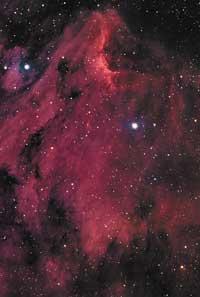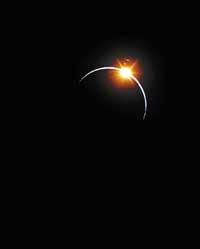Are we alone in the universe?
2002/11/16 Kortabarria Olabarria, Beñardo - Elhuyar Zientzia
It has often been asked by man. In vain, outside the Earth, no remains of life have been found. And he is looking for. The most powerful telescopes on Earth and in the orbit of Earth explore the farthest places. The goal now is exoplanets, that is, planets outside the Solar System. Already 100 have been found and with such a wide universe you will find much more. Is there someone else? It is still too early to respond.

The news of the last planet, beyond the Solar System, comes with autumn. According to available data, this planet is similar in size to that of Jupiter. Every four years it revolves around the star Tau 1 Gruis. It is 100 light-years from Earth and almost 500,000,000 kilometers from its star.
The news about the last exoplanet has arrived with the southern wind of autumn, despite the interest that has already been shown in this topic. And it is that in the history of mankind, not a few physicists and scientists have wanted to know whether we are alone or not in the universe. It has been 2000 years since the philosopher Epicurus lived. He left his hypothesis written: "In the universe there are many worlds like ours, with similar civilizations". Two millennia have passed to find the first exoplanets, but for the moment they do not resemble much to ours.
The systematic search for exoplanets began in 1988 at two US universities, but the discovery is only a few years ago. The first exoplanet was discovered by the French Michel Mayor and Didier Queloz in 1995 at the Haute-Provence observatory in France. 51 Pegas was called. Although they found the planet, it has not yet been possible to see neither it nor any other exoplanet. After taking into account some data and measurements, it was concluded that exoplanet existed.

Until recently, scientists have had neither technique nor adequate tools to find exoplanets. When they put the Hubble space telescope in orbit, they began to observe the zones in which the stars are formed. As a result of these observations, in 1990 the discovery of planets revolving around the bracelets was announced. The pulsars are compact stars that swivel quickly and emit electromagnetic radiation when rotating. If the direction of the turning axis of the stars is correct, this radiation can also be detected from Earth. In this case the prediction was erroneous because the data was not taken correctly. However, the planets that revolve around the bracelets have appeared later.
Although only 100 exoplanets have been found, it is evident that many of the stars have planets around them. Still not too much is known of these planets, since it converts the stars' lights into almost invisible. Most are similar to Jupiter, but this can be largely due to the search method, as it is easier to find planets with higher mass. The observations that have been made around the exoplanets determine relatively clearly the orbits of these planets, and the most surprising is the great eccentricity.

The eccentricity of most of the planets of the Solar System is very low, that is, its orbit is almost two rIbilos. However, most exoplanets have much more elliptic orbits. According to the data available today, one cannot say that there are more or less exoplanets than in an area of the sky. Moreover, if a situation map of the exoplanets found is made, it is observed that they are dispersed by space without any order, always around some star. Taking into account these data, one can hardly say anything about the number of exoplanets, since although the most recent tool has been used, only the largest exoplanets have been found. This does not mean that there are no smaller planets.
How are planetary systems formed?
The discovery of exoplanets has opened new data and pathways for scientists who investigate how planetary systems are formed. According to the most widespread theory on this subject, once the fog forms the main star, a protoplanetary disc is formed that will produce the condensation of the protoplanets. These protoplanets gradually collect the material until, years later, the planets form.

The first protoplanetary disc was discovered in 1983, around the star Beta Pictoris and at a distance of 61.5 light years. Since then, the work of the Hubble space telescope has allowed to identify more discs around the stars. Being a relatively new phenomenon, it was considered that this type of discs were relatively scarce. However, the reality is different, there have been found quite a few albums spinning around the young stars. Until then it was not seen because it was little, but because it did not have the appropriate equipment to perform the observations. In fact, the Hubble Space Telescope is the main tool that is discovering protoplanar discs. For this purpose, observe the places where stars are born, the nebulae.
According to current theories, no giant planets can be formed near the stars. However, many of the planets that have been found have the same mass as Jupiter, which are giants, and are much closer to the star than what most theories say. The only explanation for this contradiction is that these gaseous planets formed much farther from the star, and little by little they have shifted inward to the system, the star. This has been verified with some comets.

Although the first protoplanetary disk was discovered in 1983, the first planetary system outside the Solar System was identified in 1998. By then scientists already knew that there was a planet around the star Upsilon Andromedae. The data of the movement of this planet made think that there could be more planets around. In 1998 scientists found that around the star Upsilon Andromedae there were three planets. Two of these three planets are relatively close to the star and the third farther away.
Other astros related to exoplanets are brown dwarfs. They are stars, but by their small mass they are not able to develop internal nuclear reactions, while typical stars do. So, what difference do brown planets and dwarfs have? In the base is in process of formation of the zone. Brown dwarf stars are formed as a result of condensation of gas clouds, while the planets are a consequence of the disc that remains after the formation of the star. The first brown dwarf star was discovered in 1995 by scientists at the Teide observatory. Of course, since then we have been able to find more brown dwarf stars and see them with infrared telescopes, but otherwise it is not visible, since they have much more luminosity than the planets. Therefore, brown dwarf stars are bridges between stars and planets, as they indicate that stars of this size can form.
How are exoplanets detected?

Within the stars, nuclear reactions occur, so they have their own light, while the planets hardly emit their own radiation. For this reason, in order to see the planets, it is necessary to occur in the star and to receive the reflected light on the planets. However, stars shine a lot and many times that brightness covers the reflection of the lights of the planets that revolve around. The Sun, in sight, is a billion times clearer than any planet. But if you look at that same light with infrared telescopes, it sends a million times less energy. Therefore, if you want to perform a direct observation, it is logical to use infrared telescopes.
However, it has not yet been possible to see directly the exoplanet, so the first trials have been conducted based on other data. The largest and best telescopes are under construction, so it is expected that in the future the planets can be seen live. Then, with other techniques, you will be able to know what are the main characteristics of the atmosphere and what are the soil components of the planets. Now astrometry, systems based on the Doppler effect, transit of planets, direct observations and irregularities in the periods of the bracelets are used.

One of the exoplanet search systems is based on the perturbations that these planets cause in the main star. The position of the stars in the sky is quite fixed, but incomplete. Stars have their own movement, a measurable movement. According to Newton's gravitational law, anything that has mass produces a certain force of attraction over other things. Therefore, the most just thing is to think that exoplanets will try to attract the main star. Therefore, if in the stars oscillation movements are identified, this means that there is something that rotates around. However, its use requires a large amount and precision of measurements. Observations based on the Doppler effect are more reliable. In these observations, the movement, the changes in the frequency of motion waves, is also measured. With measurements of movement changes, the same is done.
It is also possible to detect exoplanets taking care of the passage of the planets. With the current tools and techniques, exoplanets cannot be seen, among other things because exoplanets emit very little light. However, if in rotation the planet passes in front of the main star, the brightness of this will be smaller, so it will be noticed. This effect is only perceptible if the planet passes between the Earth and the star when the inclination of the orbit is 90 degrees from the Earth. If the changes in the brightness of the star are a consequence of the passage of the planets, they must be cyclical, depending on the period of translation of the planet.

In addition to these indirect observations, direct observations are also being made to find exoplanets. This way, results have not yet been obtained, but they will appear someday. The telescopes are increasingly large, with greater light detection capacity. However, greatness has limits, since if the mirrors are too large the structures do not support properly the weight and the observations are not accurate. Due to the limitations in the magnitude, collaboration systems between telescopes are being developed, but there is still some coordination problem.
It is also making the way for space telescopes, although it is very expensive. Finally, there is the possibility of carrying out powerful infrared telescopes. As progress is made in all these pathways, and with the combined use of the aforementioned techniques, the possibilities of visual observation of exoplanets will increase considerably.
Published in section D2 of Deia.

Gai honi buruzko eduki gehiago
Elhuyarrek garatutako teknologia






